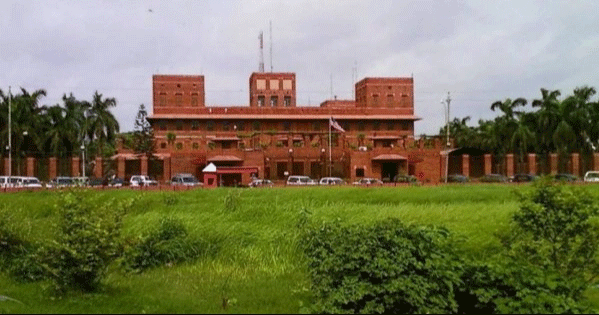Major collapse in GDP growth in Q2
Rafiqul Islam Azad : The contribution of the industry and service sectors to the Gross Domestic Product (GDP) has significantly decreased in the second quarter (October-December) of the current financial year 2023-2024.
The downturn in GDP growth is primarily attributed to political instability and uncertainty surrounding the National Assembly elections, plunging the economy into a major crisis during that period. Additionally, high inflation and reduced imports due to a dollar crisis are believed to have exacerbated the situation, according to experts.
While the agricultural sector saw an increase in growth during this period, the growth of only one sector could not stabilize the overall economy. The Bangladesh Bureau of Statistics (BBS) recently released marginal GDP statistics.
Among the three main sectors of the economy, the growth of the two largest sectors has significantly slowed, resulting in an overall decrease in GDP growth. In the second quarter of the current financial year, the overall GDP growth rate has plummeted to 3.78 percent, down from over 7 percent in the same quarter of the previous financial year. Moreover, in the second quarter of the fiscal year 2021-22, GDP growth stood at a rate of 9.30 percent.
According to BBS data, there was not only a stark contrast compared to the same period of the last two financial years but also compared to the first quarter of the current financial year, indicating a significant shock in GDP growth in the second quarter. In the first quarter (July-September) of the current financial year, GDP growth rate exceeded six percent, only to fall to less than two-thirds in the second quarter.
In the second quarter of the current fiscal year 2023-24, industrial sector GDP growth was recorded at 3.24 percent, a stark decline from 10 percent in the same quarter of the previous fiscal year 2022-23. This represents the lowest growth in the industrial sector in three financial years.
Compared to the first quarter of the current financial year, there has been a major collapse in the industry in the second quarter, with growth plummeting from 9.63 percent to one-third.
The agriculture sector experienced a growth rate of 4.65 percent in the second quarter of the current financial year, marking the highest growth in the agricultural sector in three financial years. However, despite this growth, the service sector, like the industry, witnessed a significant decline in the October-December quarter of the current financial year.
The manufacturing sector, the largest contributor among industrial sectors to GDP, saw a negative growth rate in the second quarter of the current financial year, with a decline of 0.45 percent. In contrast, the mining and quarrying sub-sector experienced a growth rate of 5.29 percent.
Within the service sector, the wholesale and retail trade, transport, and hotel trade and accommodation sectors, the three largest contributors, also experienced a decline in growth in the second quarter of the current financial year due to political unrest.
The experts attribute various ongoing economic crises, including high inflation, for the decline in GDP growth in the second quarter. High inflation has disrupted industrial production and reduced demand, while the services sector has seen reduced consumer demand. Additionally, increased loan interest rates have stalled investment.
Moreover, export trade, which plays a significant role in industrial sector growth, experienced negative growth during October-December last year, further impacting overall industrial sector growth.
This marks the first time BBS has published marginal GDP calculations in compliance with the loan conditions of the International Monetary Fund (IMF). Following the release of first-quarter data last February, second-quarter data was released on April 9th.Major Collapse in GDP Growth in Second Quarter of Current Fiscal Year
The contribution of the industry and service sectors to the Gross Domestic Product (GDP) has significantly decreased in the second quarter (October-December) of the current financial year 2023-2024.
The downturn in GDP growth is primarily attributed to political instability and uncertainty surrounding the National Assembly elections, plunging the economy into a major crisis during that period. Additionally, high inflation and reduced imports due to a dollar crisis are believed to have exacerbated the situation, according to experts.
While the agricultural sector saw an increase in growth during this period, the growth of only one sector could not stabilize the overall economy. The Bangladesh Bureau of Statistics (BBS) recently released marginal GDP statistics.
Among the three main sectors of the economy, the growth of the two largest sectors has significantly slowed, resulting in an overall decrease in GDP growth. In the second quarter of the current financial year, the overall GDP growth rate has plummeted to 3.78 percent, down from over 7 percent in the same quarter of the previous financial year. Moreover, in the second quarter of the fiscal year 2021-22, GDP growth stood at a rate of 9.30 percent.
According to BBS data, there was not only a stark contrast compared to the same period of the last two financial years but also compared to the first quarter of the current financial year, indicating a significant shock in GDP growth in the second quarter. In the first quarter (July-September) of the current financial year, GDP growth rate exceeded six percent, only to fall to less than two-thirds in the second quarter.
In the second quarter of the current fiscal year 2023-24, industrial sector GDP growth was recorded at 3.24 percent, a stark decline from 10 percent in the same quarter of the previous fiscal year 2022-23. This represents the lowest growth in the industrial sector in three financial years.
Compared to the first quarter of the current financial year, there has been a major collapse in the industry in the second quarter, with growth plummeting from 9.63 percent to one-third.
The agriculture sector experienced a growth rate of 4.65 percent in the second quarter of the current financial year, marking the highest growth in the agricultural sector in three financial years. However, despite this growth, the service sector, like the industry, witnessed a significant decline in the October-December quarter of the current financial year.
The manufacturing sector, the largest contributor among industrial sectors to GDP, saw a negative growth rate in the second quarter of the current financial year, with a decline of 0.45 percent. In contrast, the mining and quarrying sub-sector experienced a growth rate of 5.29 percent.
Within the service sector, the wholesale and retail trade, transport, and hotel trade and accommodation sectors, the three largest contributors, also experienced a decline in growth in the second quarter of the current financial year due to political unrest.
The experts attribute various ongoing economic crises, including high inflation, for the decline in GDP growth in the second quarter. High inflation has disrupted industrial production and reduced demand, while the services sector has seen reduced consumer demand. Additionally, increased loan interest rates have stalled investment.
Moreover, export trade, which plays a significant role in industrial sector growth, experienced negative growth during October-December last year, further impacting overall industrial sector growth.
This marks the first time BBS has published marginal GDP calculations in compliance with the loan conditions of the International Monetary Fund (IMF). Following the release of first-quarter data last February, second-quarter data was released on April 9th.
President Joe Biden tests positive for COVID-19 while campaigning in Las Vegas, has ‘mild symptoms’
International Desk: President Joe Biden tested positive for COVID-19 while traveling Wedne…








